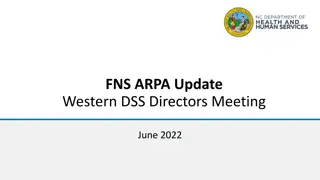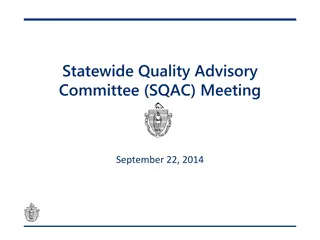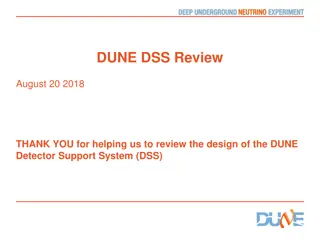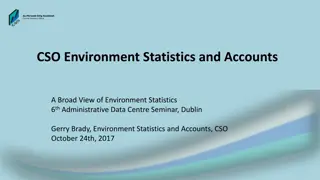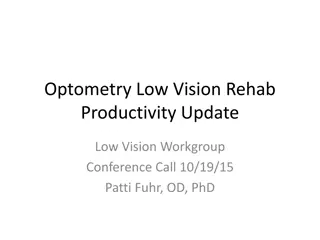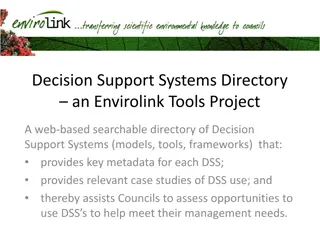DSS Meeting September 2014 Eurostat Insights
Eurostat, Data, Meeting, Regulation, Framework
Download Presentation

Please find below an Image/Link to download the presentation.
The content on the website is provided AS IS for your information and personal use only. It may not be sold, licensed, or shared on other websites without obtaining consent from the author.If you encounter any issues during the download, it is possible that the publisher has removed the file from their server.
You are allowed to download the files provided on this website for personal or commercial use, subject to the condition that they are used lawfully. All files are the property of their respective owners.
The content on the website is provided AS IS for your information and personal use only. It may not be sold, licensed, or shared on other websites without obtaining consent from the author.
E N D
Presentation Transcript
IESS Agenda point 3.1 DSS Meeting 29 - 30 September 2014 Slide 1 DSS 29-30 September 2014 Eurostat
A rapid evolution April 20144 (DSS), June (Board), September (DSS), December (Board), Many changes, reflecting views, in text, annexes, implementation, underlying concepts This time again, several changes (recitals, definitions, several articles (2-5 central), delegations, fine tuning, planning example, etc. EoV encouraging: Many convergences also needs for clarifications Slide 2 DSS 29-30 September 2014
Articulation Domain Topics Detailed topics Modules Variables Common elements Slide 3 DSS 29-30 September 2014
Need for flexibility Domain Topic Detailed topic Labour market Technical specs Module P & HH characteristics Common elements Variable Persons characteristics Sampling frames Demographic And other Sex & age Framework regulation Planning Text Annex No changes Delegated act Implementing act Limited changes Delegated act Slide 4 DSS 29-30 September 2014 Policy Technical
Framework regulation Text X X Delegated act Implementing act Annex Domains Topics Detailed topics Precision requirements Sample characteristics Planning Elements common Technical specifications Transmission standards Peridodicity Transmission deadlines Sampling frames Quality standards Derogations X X X X X X X X X X X X X X X Slide 5 DSS 29-30 September 2014
Other considerations Example of planning act (art. 3) Precision req. and sample char. annexes: no change Work is being continued in all relevant WGs and TFs Slide 6 DSS 29-30 September 2014
Article 1 Subject matter 1. This Regulation establishes a common framework for European statistics relating to persons and households, based on data at individual level collected by samples. In order to produce such statistics, data shall be collected for samples of persons or households. 2. This regulation does not apply to population and housing censuses referred to in the Regulation (EC) No 763/20081. Slide 7 DSS 29-30 September 2014 1 Regulation(EC) No 763/2008 of the European Parliament and the Council of 9 July 2008 on population and housing censuses, (OJ L 218, 13.8.2008, p.14)
Article 2 Data collections 1.The collection of the data referred to in Article 1 shall be organised into the following domains: labour market, income and living conditions, health, education and training, use of information and communication technologies, time use, consumption, tourism. 2.The data collections shall cover the following topics, as further detailed in Annex 1: labour market participation and perspectives, job tenure and previous work experience, working conditions including working hours and working time arrangements, educational attainment and background, participation in education and training and perspectives, health (including disability), income, consumption and wealth, including debts, living conditions, including material environment, access to services including childcare, quality of life, including social and cultural participation and wellbeing, allocation of time, consumption expenditure, information society participation, national tourism. as well as persons and household characteristics and technical items. deprivation, housing, living Slide 8 DSS 29-30 September 2014
3 1.The precision requirements and sample characteristics for each domain shall be as specified in Annex II and Annex III, respectively. 2.The Commission shall be empowered to adopt delegated acts in accordance with Article 14 to amend the detailed topics of Annex I to relevant technical and economic developments and new users needs. In exercising its power pursuant to this article to amend the detailed topics of the Annex I, the Commission shall ensure that: 4 a) such delegated acts do not impose a significant additional administrative burden or cost on the Member States or on the respondent units; b) a maximum of 20 percent of the detailed topics listed in Annex I are changed by delegated acts, representing a change of a maximum of 20 percent of the list of variables collected. These two maximum percentages shall apply to any period of a length of 4 calendar years. Slide 9 DSS 29-30 September 2014
Article 3 Multiannual rolling planning 1.The Commission shall be empowered to adopt delegated acts in accordance with Article 14 establishing a multiannual rolling planning for eight years for the statistics covered by this Regulation or adapting it. The Commission shall ensure that such delegated acts do not impose a significant additional administrative burden or cost on the Member States or on the respondent units. This planning shall define: (a) for each data collection, a list of regular modules for the detailed topics listed in Annex I; (b) the supplementary modules that might be attached to data collections; (c) the period during which data attached to each module is collected. 2.The adaptation of the planning referred to in paragraph 1 shall be made no later than 24 months before the beginning of the field work of the first data collection provided for in the planning. 3.The adaptation referred to in paragraph 1 above shall aim to ensure consistency of the planning with the users' needs and the selected detailed topics. [NB: ICT domain is a special area with specific current practices that works well and should be preserved.] Slide 10 DSS 29-30 September 2014
Annex I: list of regular modules Modules for all domains Topic Technical items Person and household characteristics Income, consumption and wealth, including debts (t.b.c.) Labour market participation and perspectives Educational attainment and background Health (including disability) Detailed topic Technical items Person characteristics Household characteristics Income at household level (t.b.c.) Module Data collection information Identification Weights Interview characteristics Localisation Demography Citizenship and migrant background Household composition Monthly income (t.b.c.) Acronym All-DS All-DS All-DS All-DS All-CV All-CV All-CV All-CV All-CV Self-perceived main activity status Elementary job characteristics Educational attainment Elementary health status (t.b.c.) Self-perceived main activity status Elementary job characteristics Educational attainment level Health All-CV All-CV All-CV All-CV Modules for the domain labour market Detailed topic Employment status Job characteristics Occupation Characteristics of the workplace Looking for work Second job Looking for other job Reconciliation between work and family life Young people on the labour market Labour market situation of migrants and their immediate descendants Transition into retirement Care needs Topic Labour market participation and perspectives Module Employment status Duration of contract - reason FTPT status - reason Dependent self-employment Occupation Supervisory responsibilities Economic activity Establishment size Workplace Working at home Search for work Willingness to work Availability Second job Looking for other job Reconciliation between work and family life Young people on the labour market Labour market situation of migrants and their immediate descendants Transition into retirement Care needs Acronym LFSQ LFSY LFSQ LFSY LFSQ LFSY LFSQ LFSY LFSQ LFSY LFSQ LFSQ LFSQ LFSQ LFSY LFS8YF LFS8YE LFS8YC LFS8YD LFSY Slide 11 DSS 29-30 September 2014
Annex II: list of supplementary modules Domain Supplementary module Acronym Labour market Subject 1 LFSSM1 Subject 2 LFSSM2 Income and living conditions e. g. coping strategies SILCSM1 Subject 2 SILCSM2 Subject 3 SILCSM3 Slide 12 DSS 29-30 September 2014
Annex III: periods during which data attached to each module is collected NB: At this stage, the Xs in the table have been allocated at random for illustration purposes. Identification Periodicity Period of data collection 2021 2022 Domain Acronyms of the modules 2019 2020 2023 2024 2025 2026 Labour market Quarterly LFSQ, ALL-DS and ALL-CV X X X X X X X X Yearly LFSY, ALL-DS and ALL-CV X X X X X X X X 2 Yearly LFS2YA X X X X LFS2YB X X X X In addition to the yearly modules 8 Yearly LFS8YA X LFS8YB X LFS8YC X LFS8YD X LFS8YE X LFS8YF X Supplementary modules LFSSM1 X LFSSM2 X Income and living conditions Yearly SILCY, ALL-DS and ALL-CV X X X X X X X X 3 Yearly SILC3YA X X X In addition to the yearly modules SILC3YB X X X SILC3YC X X 6 Yearly SILC6YA X X SILC6YB X SILC6YC X Supplementary modules SILCSM1 X Slide 13 DSS 29-30 September 2014
Article 4 Elements common to several data collections 1.When specific elements may be common to several data collections, the Commission shall be empowered to adopt implementing acts for the purpose of specifying the following elements of the data to be transmitted under this Regulation: (a) the list and description of variables; (b) the statistical classifications; (c) the statistical populations and observation units. 2.These implementing acts shall be adopted in accordance with the examination procedure referred to in Article 15(2). Slide 14 DSS 29-30 September 2014
Article 5 Technical specifications of data collections 1.The Commission shall be empowered to adopt implementing acts setting out the following technical specifications for each data collection: (a) the list and description of variables; (b) the statistical classifications; (c) the statistical populations and the observation and respondent units; (d) the reference periods and dates; (e) the requirements concerning geographical coverage, sample characteristics, technical aspects of the field work, and other specifications covering imputation and editing, weighting and variance estimation. (f) when necessary for achieving a high level of comparability and in limited cases and for limited variables, the instruments to be used to collect the data. This may include, when necessary, the formulation of the questions, their order and location in the questionnaire and other appropriate means. 2.These implementing acts shall be adopted in accordance with the examination procedure referred to in Article 15(2). Slide 15 DSS 29-30 September 2014
Article 6 Standards for transmission and exchange of information 1.Technical standards shall be established to facilitate the exchange and sharing of information and to support quality management and process documentation related to statistics under this Regulation. 2.The standards shall cover statistical concepts, processes and products, including data and metadata. 3.The Commission shall be empowered to adopt implementing acts to establish the technical standards referred to in paragraph 1. Those implementing acts shall be adopted in accordance with the examination procedure referred to in Article 15(2). Slide 16 DSS 29-30 September 2014
Article 7 Terminology For the purposes of this Regulation the following terminology shall apply: [Note: this list of terminology is only for terms which are needed for the understanding of the regulation itself. The statistical definitions would be in delegated or implementing acts, see Articles 4 and 5] (a) microdata means non-aggregated observations, or measurements of characteristics of individual units , usually the person or the household; (b) confidential microdata means data which allow units to be identified, either directly or indirectly, thereby disclosing individual information; (c) aggregated data means the result of transforming microdata into quantitative measures; (d) pre-checked data means data verified by the Member States, on the basis of agreed common rules; (e) data collection means a set of microdata, combining variables collected about the same observation units organised according to the domains referred to in article 2, paragraph 1; (f) topic and detailed topic mean the content of the information to be collected about the observation units. Topics and detailed topics differ as regards their level of details. A topic is organised to cover a number of detailed topics; (g) domain means one or several data collections organised in order to cover particular topics; (h) module means a set of variables pertaining to a detailed topic; (i) regular module means a module implemented on the basis of a defined periodicity; (j) supplementary module means a module not implemented on the basis of a defined periodicity or only once, limited in size and intending to meet specific users needs; (k) variable means elementary information collected about the observation units. The value of a variable is an absolute figure or a reference to a position in a classification; (l) sample means a subset of a frame where elements are selected based on a process with a known probability of selection, designed so as to allow to derive estimations valid for the statistical population; (m) sampling frame (or frame) means a list of the statistical population of units from which a sample can be selected; (n) observation unit means. the entity being studied and about which data is collected (usually persons or households), ; (o) responding unit means the unit that supplies information to the survey authority. It reports information for each of the observation units. In certain cases it may correspond to an observation unit. (p) statistical population means the set of entities about which information is wanted and estimates are required; Slide 17 DSS 29-30 September 2014
Article 8 Data sources 1.Member States shall collect the data referred to in Article 1 by using one or a combination of the following sources provided that they are appropriate in terms of quality in accordance with Article 11: (a) information directly provided by the respondent unit ; (b) administrative records and any other sources or methods in so far as they allow for the production of data that are comparable and compliant with applicable specific requirements in accordance with art 5.1.f. Member States shall inform the Commission (Eurostat) and shall transmit details concerning the sources used. Slide 18 DSS 29-30 September 2014
Article 9 Periodicity of the data collection and transmission deadlines 1.The periodicity of the data collections shall be as specified in Annex IV. 2.Pre-checked microdata shall be transmitted to the Commission (Eurostat) for every data collection. 3.The transmission deadlines shall be as established in Annex V. 4.Aggregated data shall be transmitted in accordance with the specifications provided in Annex VI. The Commission shall be empowered to adopt delegated acts in accordance with Article 14 to amend Annexes IV and V. The Commission shall ensure that such delegated acts do not impose a significant additional administrative burden or cost on the Member States or on the respondent units. Slide 19 DSS 29-30 September 2014
Article 10 Sampling frames 1.Data shall be based on representative samples drawn from sampling frames at national level allowing the random selection of persons, with a known probability of selection. 2.When no such sampling frame of persons is available in the Member State, other sampling frames having the following characteristics shall be used: (a) identification of the sample unit: persons, households, dwelling or addresses; (b) known prior probability of selection; (c) regular update of the frame. The Commission shall be empowered to adopt implementing acts laying down uniform conditions for the sampling frames, notably setting out their minimum requirements. Those implementing acts shall be adopted in accordance with the examination procedure referred to in Article 15(2). Slide 20 DSS 29-30 September 2014
Article 11 Quality 1.Member States shall take all measures necessary to assure the quality of the statistics transmitted. 2.For the purpose of this Regulation, the quality criteria defined in Article 12(1) of Regulation (EC) 223/2009 shall apply. 3.The Commission (Eurostat) shall assess the quality of the metadata on the specifications, of the microdata transmitted and of the sampling frames. 4.For this purpose, Member States shall transmit alongside the microdata referred to in Article 9: (a) metadata explaining specifications used for data collections by reference to those laid down in the relevant implementing acts referred to in Articles 4 and 5; (b) information on the application of the minimum requirements for the sampling frames used as referred to in Article 10 including their establishment and updating. 5.Member States shall transmit the elements referred to in Article 11(4) by means of quality reports showing in particular the required quality assurance of the statistics transmitted and of these elements. 6.The Commission shall be empowered to adopt implementing acts setting out the modalities, content and frequency of the quality reports. These implementing acts shall be adopted in accordance with the examination procedure referred to in Article 15(2). 7.Member States shall inform the Commission (Eurostat), as soon as they become known, about any relevant information or change with regard to the implementation of this Regulation that would influence the quality of the statistics transmitted. 8.At the request of the Commission (Eurostat), Member States shall provide it with the additional information necessary to evaluate the quality of the statistical information. Slide 21 DSS 29-30 September 2014
Article 12 Feasibility studies In order to increase the flexibility of the organisation of the collection of data, Member States shall carry out several feasibility and pilot studies. The purpose of such studies shall be to analyse the possibility for Member States to allocate each module to the appropriate collection of data, provided that it allows for the joint analysis of the variables of interest and meets the specified precision requirements, periodicity, sample characteristics and transmission deadlines. Slide 22 DSS 29-30 September 2014
Article 13 Financing 1.For the implementation of this Regulation, the Union may provide financial support to the national statistical institutes and other national authorities referred to as designated beneficiaries in Article 5(2) of Regulation (EC) No 223/2009, towards the cost of (a) the development and/or implementation of data collections for social statistics, including sampling frames, which may be particularly expensive during the first four years; (b) developing new statistics or methodologies, including the feasibility and pilot studies referred to in Article 12; (c) collecting statistics through supplementary modules , new modules implemented for the first time or revised modules ; 2.The amount of the appropriations allocated annually for the financial contribution referred to in paragraph 1 shall be fixed as part of the annual budgetary procedures. 3.The budget authority shall grant the appropriations available for each year. Slide 23 DSS 29-30 September 2014





